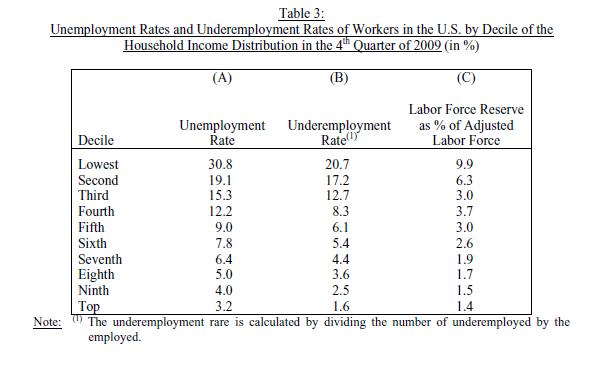 The mainstream media is full of happy economic news these days. The S&P 500 has shot up 16 percent since the beginning of July. Ford Motor Company just reported a profit that jumped nearly 70 percent in the third quarter. It was Ford’s best third quarter performance ever and it was the 6th quarterly profit in a row for the company. Other major firms have announced earnings that have far exceeded expectations in recent weeks. Hooray! The pundits are proclaiming that the economic collapse is over and that the U.S. economy has won. It is almost enough to make one tear into a stirring rendition of “Happy Days Are Here Again”. But perhaps we should take a moment and get a hold of ourselves first. After all, the underlying economic fundamentals have not changed. The same long-term trends that were ripping the U.S. financial system apart a month or two ago are still continuing to do so. Millions upon millions of American families are still deeply suffering. So exactly what in the world is going on here? Well, this is what is known as a “sucker’s rally”. Those on the inside know better than to throw money at this market. In fact, corporate insiders are now selling off stock so fast you would think it is going out of style. Meanwhile, hordes of innocent rubes are jumping back into the stock market thinking that it is the perfect time to get in.
The mainstream media is full of happy economic news these days. The S&P 500 has shot up 16 percent since the beginning of July. Ford Motor Company just reported a profit that jumped nearly 70 percent in the third quarter. It was Ford’s best third quarter performance ever and it was the 6th quarterly profit in a row for the company. Other major firms have announced earnings that have far exceeded expectations in recent weeks. Hooray! The pundits are proclaiming that the economic collapse is over and that the U.S. economy has won. It is almost enough to make one tear into a stirring rendition of “Happy Days Are Here Again”. But perhaps we should take a moment and get a hold of ourselves first. After all, the underlying economic fundamentals have not changed. The same long-term trends that were ripping the U.S. financial system apart a month or two ago are still continuing to do so. Millions upon millions of American families are still deeply suffering. So exactly what in the world is going on here? Well, this is what is known as a “sucker’s rally”. Those on the inside know better than to throw money at this market. In fact, corporate insiders are now selling off stock so fast you would think it is going out of style. Meanwhile, hordes of innocent rubes are jumping back into the stock market thinking that it is the perfect time to get in.
The truth is that these “good times” are only temporary. Don’t get used to them. The following are 30 reasons why people should be getting really, really nervous about the state of the U.S. economy….
#1 Corporate insiders are selling off stock at a blinding pace and are looking for the exits. Alan Newman, the editor of the Crosscurrents newsletter, examined a number of the top performing stocks in the market including Google, Apple and Target and found that the ratio of corporate insider stock sold to corporate insider stock purchased over the last six months for those companies was 3,177 to 1. At the group of firms that Newman looked at, corporate insiders had purchased 38,000 shares of stock over the last six months and yet had sold off over 120 million shares.
#2 Analysts at both Bank of America and Goldman Sachs both believe that the U.S. Federal Reserve is going to initiate a new round of quantitative easing in November. It does not take a genius to figure out that this is very likely to push up inflation and have very serious consequences for the U.S. dollar.
#3 Economists at Goldman Sachs are projecting that the Fed will have to purchase at least $4 trillion in assets during this next round of quantitative easing to get the U.S. economy moving in a positive direction once again.
#4 In the United States today, there are 5,057 janitors with Ph.D.’s, other doctorates, or professional degrees.
#5 Investors have very little faith in the U.S. dollar (and in paper currencies in general) at this point. Precious metals are soaring to obscene heights. The price of gold has increased more than 20 percent in 2010. The price of silver has skyrocketed about 40 percent this year. These are not signs that indicate that the U.S. financial system is stable.
#6 Robin Griffiths, a technical strategist at Cazenove Capital, told CNBC on Monday that the U.S. dollar is in danger of becoming “toxic waste”.
#7 In the United States today, 317,000 waiters and waitresses have college degrees.
#8 U.S. lending institutions repossessed an all-time record total of 102,134 homes in the month of September. That was the first time that home repossessions in the U.S. had ever exceeded the 100,000 mark during a single month.
#9 According to a Standard & Poor’s/Case-Shiller home price report that was released on Tuesday, single family home prices in the United States declined for a second straight month in August.
#10 In the United States today, over 18,000 parking lot attendants have college degrees.
#11 During the months of August and September, the state of Nevada had an unemployment rate of 14.4 percent, which was the highest in the history of the state. Not that the rest of the country is doing any better. The state of California has become a complete and total economic disaster zone, and the city of Detroit, Michigan is literally dying.
#12 The “official” unemployment rate in the United States has been at nine and a half percent or above for 14 consecutive months.
#13 The number of people unemployed in the state of California is approximately equivalent to the populations of Nevada, New Hampshire and Vermont combined.
#14 According to the president of the Federal Reserve Bank of New York, there are approximately 3 million more vacant housing units than usual in the United States.
#15 China has reduced the export quota on rare earth elements for the second half of 2010 by 72%, thus strengthening their position in the world economy even more. Rare earth elements are absolutely crucial to the manufacture of a vast array of high technology products, and now even more of them will have to be made in China.
#16 In 1985, the U.S. trade deficit with China was 6 million dollars for the entire year. In the month of August alone, the U.S. trade deficit with China was over 28 billion dollars.
#17 Wheat, corn and other staples are absolutely soaring in price on world markets. These higher food prices are going to hit U.S. consumers hard.
#18 In 2007, 3 U.S. banks failed. In 2008, 25 U.S. banks failed. In 2009, 140 U.S. banks failed. Last Friday, it was announced that 139 U.S. banks have failed so far this year and it is not even the end of October yet.
#19 Total student loan debt in the United States is climbing at a rate of approximately $2,853.88 per second.
#20 Back in 1980, the United States imported approximately 37 percent of the oil that we use. Now we import nearly 60 percent of the oil that we use.
#21 According to an analysis by the Congressional Joint Committee on Taxation, the health care reform legislation that Congress didn’t read but passed into law anyway will generate $409.2 billion in additional taxes on the American people by the year 2019.
#22 Median household income in the U.S. declined from $51,726 in 2008 to $50,221 in 2009. That was the second yearly decline in a row.
#23 One out of every six Americans is now enrolled in a government anti-poverty program, and yet the number of Americans signing up for food stamps and other social programs just continues to set new all-time records month after month after month.
#24 The number of Americans working part-time jobs “for economic reasons” is now the highest it has been in at least five decades.
#25 American 15-year-olds do not even rank in the top half of all advanced nations when it comes to math or science literacy.
#26 According to a recent poll conducted by CNBC, 92 percent of Americans believe that the performance of the U.S. economy is either “fair” or “poor”.
#27 After analyzing Congressional Budget Office data, Boston University economics professor Laurence J. Kotlikoff came to the conclusion that the U.S. government is now facing a “fiscal gap” of $202 trillion dollars.
#28 A trillion $10 bills, if they were taped end to end, would wrap around the earth more than 380 times. That amount of money would still not be enough to pay off the U.S. national debt.
#29 According to the U.S. Treasury Department, the U.S. national debt is rapidly closing in on 14 trillion dollars and and will climb to an estimated $19.6 trillion by 2015.
#30 At our current pace, the Congressional Budget Office is projecting that U.S. government public debt will hit 716 percent of GDP by the year 2080.
The U.S. economy is in the midst of a long-term decline. There are always going to be moments when it seems like things are getting a bit better, but then reality will kick in and the depressing slide will continue.
If you really want to understand what is happening to the U.S. economy, do not become fixated on the short-term numbers. Instead, always keep an eye on the long-term trends.
The U.S. economy is dying. We are getting whipped by the rest of the world and we are drowning in a sea of debt. A little rally in the stock market is not going to do a thing to fix our very deep fundamental economic problems.










